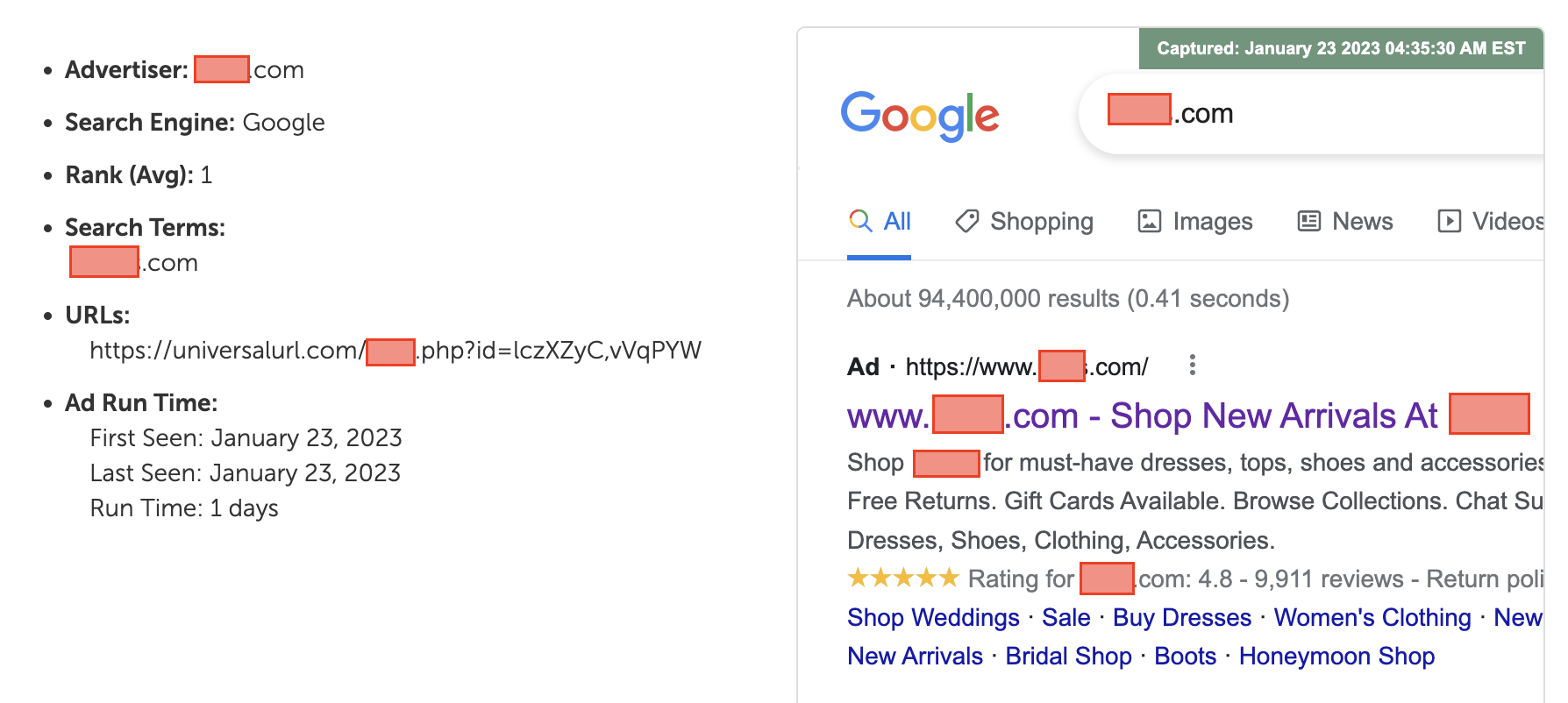Jump to section
What is Affiliate Ad Hijacking?
Branded pay-per-click ad campaigns—in which you bid on your own brand keywords—are the cost-effective means of driving sales and leads. For less-than-ethical affiliates, targeting your branded keywords can prove to be a temptation too powerful to resist.
If you’ve seen a decline in the impressions, clicks, and conversions of your branded ad campaigns, then you may be the victim of an affiliate ad hijacker.
In this article, you’ll learn:
- What is affiliate hijacking
- What affiliate ad hijacking looks like
- Why affiliate ad hijacking is harmful
- How to tell if affiliates are hijacking your ads
- How to stop affiliate ad hijacking
What is affiliate ad hijacking?
Affiliate ad hijacking is also referred to as “affiliate hijacking,” and sometimes as “URL hijacking” or “direct linking”, though the latter is a broad umbrella that encompasses other forms of interference in paid and organic SERPs.
Affiliate hijacking occurs when an affiliate designs an ad so that it looks as much as possible like an official brand’s ad, with the intention of misleading online shoppers, using the same display URL as the brand’s, and directing clicks from the ad through an affiliate redirect, and directly to the brand’s website, without first landing on a web page controlled by the affiliate.
What does affiliate ad hijacking look like?
Deceptive affiliates will create ads which use branded terms in the copy and headlines if they can manage to do so without getting flagged by Google Ads or Microsoft Ads. But otherwise they will duplicate the titles and ad copy of genuine branded ads as much as possible so that the two are difficult to tell apart.
Hijacked ads will always feature display URLs which are identical to the ads being duplicated—especially because the display URL is the one part of the ad in which Google Ads and Microsoft Ads allow the use of trademarked terms by advertisers which don’t hold the rights to those trademarks. However, these platforms often fail to prohibit affiliates from prominently featuring brand names in ad headlines and copy.

In the above screenshot from a brand violation report generated for a women’s clothing outlet, a search for “[brand].com” has returned the ad shown on the right, which prominently features the brand name in the display URL, headline, and copy.
However, the ad has not been placed by the clothing outlet, but instead by an affiliate bidding on “[brand].com.” The ad links to universalurl.com, with a unique tracking link, which redirects directly to the clothing outlet’s homepage. The affiliate is doing nothing but acting as an unnecessary intermediary, duplicating the brand’s existing ad, bidding up their branded terms, and taking credit for sales resulting from traffic funneled through the ad.
Why is affiliate ad hijacking harmful?
Perhaps the most immediately damaging consequence of ad hijacking by affiliate marketers is that when their ads are shown, genuine branded ads are not. This is because Google Ads and Microsoft Ads will not display multiple ads at the same time which share the same display URL. If your affiliate’s ad is showing, then yours cannot. If your affiliate outbids you, you aren’t relegated to second place—your ad doesn’t show at all. Even when your ads do show, your average cost per click will be driven up as a result of the affiliate bidding on your keywords.
But the harm doesn’t end there. Affiliate hijackers drive clicks through their tracking links, typically masked with redirects so that it’s more difficult for the brands they’re interfering with to identify the culprits. Ultimately, they earn a commission from clicks they never should have gotten in the first place.
There are also secondary consequences of ad hijacking. Such affiliates may use brand messaging which is out of date or inaccurate, diminishing the perceived prestige of the brand.
To summarize the above, the consequences of ad hijacking can include:
- Reduced impressions, clicks, and sales from branded campaigns attributed to your SEM efforts
- Increased CPCs because you are competing with yourself
- Inflated affiliate commission costs
- Misleading or inflated auction insights data. Since the affiliate is marketing their ads using your top level domain as the display URL, auction insights will include the affiliate’s ad performance in your auction insights report
- Brand damage
How do you tell if affiliates are hijacking your ads?
In most instances, you will not be able to tell whether an affiliate is hijacking your ads simply by looking at an ad, unless you notice the use of unapproved messaging. That is what makes ad hijacking such a challenging problem to detect and eliminate, as hijacked ads look like official, branded ads, and ultimately take shoppers to the expected destination on your site. The only tell is the brief redirect from the search engine, through the affiliate’s tracking URL, and finally to your site.
Note that nefarious affiliates may use ad scheduling, tracking URLs that resemble your ad tracking provider URLs, and geotargeting settings that make it difficult to catch them in the act. For instance, they may only run their ads outside of normal office hours, or in regions where they believe you don’t monitor performance as closely.
Generally, affiliate hijacking is noticed when scrutinizing analytics and other ad data. The biggest tells include:
- Declining impressions, clicks, and conversions in your branded ads
- Increases in referral traffic
- Increases in affiliate commissions
- Affiliates with conversion rates very similar to that of your branded campaigns
How do you stop affiliate ad hijacking?
First, you’ll want to have evidence of ad hijacking in action. Tools like the Live HTTP Headers extension can capture a log of the path through which you are redirected when clicking on an affiliate link. But if you need to continuously monitor a large number of ads, you will need to utilize a service like The Search Monitor to develop a robust, automated affiliate monitoring process. We routinely see major brands losing 20% to 30% of branded ad impressions to affiliate ad hijacking. The cost of this can measure in the millions of dollars per year—a cost which can be eliminated for pennies on the dollar with the right enforcement system.
Secondly, review your affiliate agreements and make sure they clearly define what activities are disallowed, and the consequences for engaging in forbidden behavior. The more specific the agreement, the better. For example, you may include a list of branded keywords which affiliates are forbidden from bidding on. You may also prohibit them from bidding for the top position on branded terms, place restrictions on ad copy (e.g. using the term “official site”), and specify that any website owned or operated by the affiliate is not allowed to bid on branded keywords (to prevent them from circumventing the agreement by signing up for a secondary affiliate program). When affiliates run afoul of agreements, present them with the evidence of their misbehavior, and enforce your agreements.
Where possible, seek out affiliates which allow you to set up brand restrictions ahead of time. If they proactively give you the tools to protect your brand, they’re more likely to comply with your affiliate agreements, and will have even fewer excuses for failing to do so.
Be proactive in protecting your brand, your business, and your customers. If you know you don’t have the tools or data necessary to do so, then contact us and we’ll work with you to determine if The Search Monitor can help you achieve your goals.
Share on Social
See Our Data at Work
Provide us with a competitor’s website, a set of keywords, or one of our 1,000+ verticals, and we’ll show you the power of our monitoring capabilities. Request a personalized demo today and see what our insights can do for you!
Trusted by








 Brand Protection
Brand Protection SEM Insights
SEM Insights Affiliate Compliance
Affiliate Compliance Ad Armor
Ad Armor Learning Center
Learning Center Guides & Webinars
Guides & Webinars We Love Data™
We Love Data™ About Us
About Us Our Data
Our Data Careers
Careers Our Team
Our Team News
News Contact Us
Contact Us
